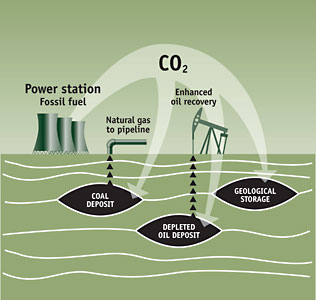UK university launches carbon capture research centre
 Nottingham, UK (GLOBE-Net) - The University of Nottingham will established a new £1.1m research centre to develop carbon dioxide capture and storage technologies.
Nottingham, UK (GLOBE-Net) - The University of Nottingham will established a new £1.1m research centre to develop carbon dioxide capture and storage technologies.
Dr Mercedes Maroto-Valer, Associate Professor and Reader in Energy Technology, has received £1.1m for the new Centre for Innovation in Carbon Capture and Storage (CICCS), due to open in October 2007.
The Engineering and Physical Sciences Research Council (EPSRC), through the Challenging Engineering initiative, has just announced a five-year funding package for CICCS, aiming to establish it as a world leader in the development of novel processes for carbon capture and storage and establishing partnerships with major international industries and research centres.
The Centre will work on research at the interface of science and engineering, industry and international cooperation in order to accelerate technological innovation in the field and lead to a wider deployment of carbon capture and storage. The Centre will also have a strong programme of knowledge transfer and training with a range of opportunities for industrial engagement.
The Centre will promote interdisciplinary activity to bring ideas from basic science and develop them into new products, processes and services, as well as consider public acceptability issues.
One of the technologies that the Centre will work on uses a natural process in conjunction with silicate-based rocks such as serpentine, which is found in large enough quantities, and in the right places, to store all the CO2 produced by the combustion of the entire world’s known fossil fuel reserves.
The CO2 extracted from burning coal is put into a reactor with the rocks and through a chemical reaction. The serpentine binds the carbon dioxide to itself, ‘locking it in’ permanently. This reaction does occur in nature - only far more slowly, taking place over eons of time.
Once the process is fully developed, it is estimated that the locking of CO2 will take place within minutes.
The end product is a mineral such as magnesite, which can be used as aggregates for road-building or shaped into bricks for construction. Carbon dioxide makes up 40 per cent of its weight and it would take 1,500 times more space to store the same amount in gas form.
Compared to other proposed processes for carbon storage, such as burying carbon under the sea, once the CO2 is locked inside the rock by the CICCS process, it is contained for good and cannot go back to its previous state. This is of paramount importance as ensuring the permanent storage of the CO2 has been the most controversial issue in carbon storage.
As well, the end result is a commercial product. Fossil fuel power plants could utilise the new process by adding a reactor to their emissions treatment system, allowing CO2 to be turned into a useful building material. The Centre’s ultimate goal will be to sign collaborative agreements with power and construction companies to move forward with commercialisation of the technology.
The processes developed by the Centre will also be attractive to oil producers, chemical manufacturers and other energy-intensive industries that have a role to play in helping the UK to meet its 2050 target of 60% reduction below 1990 levels.
You can return to the main Market News page, or press the Back button on your browser.

